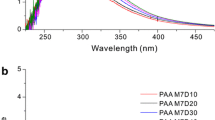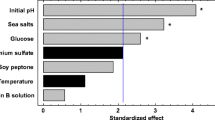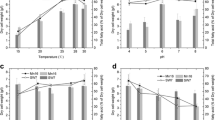Abstract
Odd-carbon fatty acids have been utilized for anaplerotic therapy for lifestyle-related diseases such as Alzheimer’s disease and diabetes. We examined the culture condition of Aurantiochytrium for the production of pentadecanoic acid (C15) as an odd-carbon fatty acid, and demonstrated a produce method for odd-carbon fatty acid–enriched triglyceride. To determine the optimum conditions for C15 production, selection of effective components and their respective concentrations in the culture medium, choice of the suitable Aurantiochytrium strain, and determination of the optimum culture pH were performed.
The optimum conditions for the production of C15 were found to be as follows:
Strain: Aurantiochytrium sp. strain SA-96
Medium composition: 0.2% yeast extract 0.5% monosodium glutamate, 1.0% sea salt, 50 mM L-Val, 25 mM sodium propionate, 3.6% glucose, and 10% soy milk whey.
Culture system: Airlift culture vessels (5.0 L) and pH controller were used. Sodium hydroxide (1.0 M) solution was used for pH adjustment. Other parameters were as follows: medium volume, 3.0 L; air supply, 1.2 vvm; temperature, 23.5–26.6 °C; pH, 7.40–7.74; culture period, 72 h.
The yield of odd-carbon fatty acids (C15, 85% of odd FA) was 1.04 g L−1.
Preparation of odd-carbon fatty acid–enriched triglyceride: Triglyceride was isolated from the extracted lipids from cultured cells and treated with ozone/hydrogen peroxide. By removing of carboxylic acid containing triglyceride, the odd-carbon fatty acid and C15 contents of the resultant triglyceride reached to 72.3 and 60.7%, respectively.




Similar content being viewed by others
References
Adachi K, Yokoyama D, Tamai H, Sadai M, Oba K (1993) Effect of the glyceride of pentadecanoic acid on energy metabolism in hair follicles. Int J Cosmet Sci 15:125–131
Baffy G (2010) Uncoupling protein-2 and cancer. Mitochondrion 10:243–252
Bottiglieri TG, Roe C (2010) Anaplerotic therapy for alzheimer’s disease and aging brain. US Patent Application 12/978,229
Feller DD, Feist E (1962) The conversion of leucine carbon into CO2, fatty acids and other products by adipose tissue. Biochim Biophys Acta 62:40–44
Forouhi NG, Koulman A, Sharp SJ, Imamura F, Kroger J, Schlze MB, Crowe FL, Huerta JM, Guevara M, Beulens JWJ, van Woudenbrgh GJ, Wang L, Summerhill K, Griffin JL, Feskens EJM, Amiano P, Boeing H, Clavel-Chapelon F, Wareham N (2014) Differences in the prospective association between individual plasma phospholipid saturated fatty acids and incident type 2 diabetes: the EPIC-InterAct case-cohort study. Lancet Diabet Endocrinol 2:810–818
Harper AE, Miller RH, Block KP (1984) Branched-chain amino acid metabolism. Ann Rev Nutr 4:409–454
Johnson JD, Muhonen WW, Lambeth DO (1998) Characterization of ATP- and GTP-specific succinyl-CoA synthetases in pigeon. The enzymes incorporate the same alpha- subunit. J Biol Chem 273:27573–27579
Kasumov T, Cendrowski AV, David F, Jobbins KA, Anderson VE, Brunengraber H (2007) Mass isotopomer study of anaplerosis from propionate in the perfused rat heart. Arch Biochem Biophys 463:110–117
Kaya K, Ikeda K, Kose R, Sakakura Y, Sano T (2015) On the function of pentadecanoic acid and docosahexanoic acid during culturing of the thraustochytrid, Aurantiochytrium sp. NB6-3. J Biochem Microb Technol 3:1–7
Kinnory DS, Takeda Y, Greenberg DM (1955) Isotope studies on the metabolism of valine. J Biol Chem 212:385–396
Lehninger AL, Nelson DL, Cox MM (2008) Principles of Biochemistry, 5th edn. W.H. Freeman and Company, New York, p 528
Ludwig ML, Mattews RG (1997) Structure-based perspectives on B12-dependent enzymes. Annu Rev Biochem 66:269–313
Matsumoto T, Takebayashi J, Ishimi Y, Ozawa C, Sano A, Hirota T, Endoh K (2012) Evaluation of cyanocobalamin in multivitamin tablets and their standard reference material 3280 by HPLC with visible detection. J AOAC Int 95:1609–1613
Metz JG, Roessier P, Facciotti D, Levering C, Dittrich F, Lassner M, Valentine R, Lardizabal K, Domergue F, Yamada A, Yazawa K, Knauf V, Browse J (2001) Production of polyunsaturated fatty acids by polyketide synthases in both porokaryotes and eukaryotes. Science 293:290–293
Miki T, Nagashima K, Tashiro F, Kotake K, Yoshitomi H, Tamamoto A, Gonoi T, Iwanaga T, Miyazaki J, Seino S (1998) Defective insulin and enhanced insulin action in KATP channel-deficient mice. Proc Natl Acad Sci U S A 95:10402–10406
Miwa I, Okuda J, Maeda J, Okuda G (1972) Mutarotase effect on micro determination of blood D-glucose oxidase. Clin Chim Acta 37:538–540
Miyamoto E, Tanioka Y, Yukino T, Hayashi M, Watanabe M, Nakano Y (2007) Occurrence of 5’-deoxyadenosyl-cobaramina and its physiological function as the coenzyme of methylmalonyl-CoA mutase in a marine eukaryotic microorganism, Schizochytrium limacinum SR21. J Nutr Sci Vitaminol 53:471–475
Murin R, Mohammadi G, Lebfritz D, Hamprecht B (2009) Glial metabolism of valine. Neurochem Res 34:1195–1203
Owen OE, Kalhan S, Hanson R (2002) The key role of anaplerosis and cataplerosis for citric acid cycle function. J Biol Chem 277:30409–30412
Pennington RJ, Appleton JM (1958) Further studies on the inhibition of acetate metabolism by propionate. Biochem J 69:119–125
Roe CR (2007) Nutrient sensor. US Patent Application 11/862,081
Roe CR (2009) Fatty acid treatment for cardiac patients. US Patent 7,592,370,B2
Rosiers CD, Labarrhe F, Lloyd SG, Chatham JC (2011) Cardiac anaplerosis in health and disease: food for thought. Cardiovasc Res 90:210–219
Shirasaka N, Hirai Y, Nakabayashi H, Yoshizumi H (2005) Effect of cyanocobalamin and p-toluic acid on the fatty acid composition of Schizochytrium limacinum (Thraustochytriaceae, Labyrinthulomycota). Micoscience 46:358–363
Song X, Tan Y, Liu Y, Zhang J, Liu G, Feng Y, Cui Q (2013) Different impacts of short-chain fatty acids on saturated and polyunsaturated fatty acid biosynthesis in Aurantiochytrium sp. SD116. J Ag Food Chem 61:9876–9881
Wettschureck N, Offermanns S (2005) Mammalian G proteins and their cell type specific functions. Physiol Rev 85:1159–1204
Author contribution statement
K.K. conceived this study. Experiments on culture mediums were performed by F.S. To obtain mutants strains, the heavy ion (12C) irradiation to a wild strain of Aurantiochytrium were performed by Y.K and T.A. K.K analyzed the results, designed figures, and wrote the manuscript.
Author information
Authors and Affiliations
Corresponding author
Ethics declarations
Competing interests
The authors declare no competing interests.
Additional information
Publisher’s note
Springer Nature remains neutral with regard to jurisdictional claims in published maps and institutional affiliations.
Rights and permissions
About this article
Cite this article
Kaya, K., Kazama, Y., Abe, T. et al. Influence of medium components and pH on the production of odd-carbon fatty acids by Aurantiochytrium sp. SA-96. J Appl Phycol 32, 1597–1606 (2020). https://doi.org/10.1007/s10811-020-02111-6
Received:
Revised:
Accepted:
Published:
Issue Date:
DOI: https://doi.org/10.1007/s10811-020-02111-6




